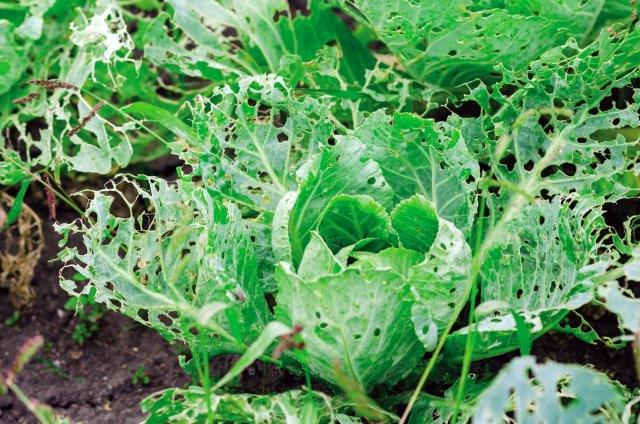Cabbage worms can be quite the annoyance as they chew their way through your harvest. They are greatly an annoyance as they produce several generations a growing season perpetuating their damage if not stopped.
When surveying your garden be sure to watch for these little green guys as they can easily camouflage with your green and leafy crops. The sooner you can catch their presence the better as they start eating from the outer leaves working their way inwards.
Early actions just might save your favorite leafy crops in time for a great harvest.
How to Get Rid of Cabbage Worms
- Cabbage Worm Distribution: Native throughout North America in greenhouses and warmer winter climates
- Cabbage Worm Host Plants: Nearly any fruit, vegetable or ornamental greenhouse crop, with the most damage done to crucifers
- Cabbage Worm Lifespan: ~4 weeks as larval looper (~10-14 days as adult moth)
- Cabbage Worm Eggs Laid per Lifetime: ~250-350
- Cabbage Worm Removal: Predatory insects, neem oil, castile soap, BT spray (Bacillus Thuringiensis), pyrethrin spray, spinosad
- Cabbage Worm Predators: Parastic wasps, lacewings, ladybugs, spiders, grasshoppers, birds
- Most Common Cabbage Worm in North America: Imported Cabbageworm Pieris rapae

What Do Cabbage Worms Look Like?
Cabbage Worms are identified by their velvety green bodies with faint yellow stripes running from end to end. Because they can look very similar to Cabbage Loopers it is important to notice the difference in how their bodies move.
A Cabbage Looper will scrunch its body up as it doesn’t have legs through its midsection while the Cabbage Worm will move its entire body together. After experiencing their pupation period, the Cabbage Worms emerge early in the spring as the Cabbage White Butterflies.
Their chrysalis is typically 18-20 mm long and a variety of colors including yellow, gray, green, and speckled brown. As adults they have small white wings marked with dark tips and one black dot if male, or two if female.
Cabbage Worm Damage
Most of the damage seen by Cabbage worms is done while in the larval stage. At this time their main food source is your beautiful garden. After hatching they immediately begin feeding on the nearby plant material leaving small holes in the foliage of the host plants.
Begin searching for damage at the base of your plants. As they grow over the next 2-3 Weeks they will continue to feed, creating larger holes possibly leading to entire plants being bare with the exception of large stems and veins. Besides preventing foliar damage it is important to control Cabbage Worm presence in order to prevent contamination of produce via their fecal matter.
If they are present make sure to sufficiently wash your produce before consuming.

What Do Cabbage Worms Eat?
Cabbage Worms are highly attracted to plants within the cabbage family. The most popular host plants include cabbage, kale, cauliflower, broccoli, brussel sprouts, and collards.
They do not stop with this list alone. If you have a crop that is mildly desired by Cabbage Worms it could be beneficial to companion plant thyme to repel or a mustard crop in an effort to distract any present population from destroying your harvest opportunities.
The only other planting options are to stick to red leafed varieties as it is harder for the green worms to camouflage, preventing their populations from flourishing. Other preventative measures include utilizing row covers to prevent adult butterflies from laying their eggs on your up and coming plants.
Cabbage Worm Eggs

Cabbage Worm eggs can be found on the underside of leaves over several weeks as eggs are laid individually. They are very small measuring only 0.5mm wide and 1.0mm long with an overall bullet shape and yellow coloration.
The larvae will hatch from the eggs within 3-5 days. Because of the short lifespan of the Cabbage Worms and Cabbage White Butterflies it is possible to have 6-8 generations a year.
To prevent more eggs from being laid you can implement the use of yellow sticky traps to catch some of the adults as well as row covers to prevent more adults from traveling to your plants.
How to Get Rid of Cabbage Worms
The good news is that you have several options to control the Cabbage Worm population. The first is to manually remove the eggs, larvae, and chrysalis. This isn’t the most efficient way but it is effective if they are properly disposed of.
As was mentioned before, yellow sticky traps may also be used to catch adult butterflies. As for products you can apply diatomaceous earth, Bacillus thuringiensis, and Sevin will be the most effective. If using Sevin double check you are applying as directed on the label.
Some biological control options include trichogramma wasps to parasitize the eggs (do not sting humans), yellowjackets, parasitic flies, green lacewings, predatory beetles, spiders, and birds.
Cabbage Worm Pesticide

- Diatomaceous Earth - One of the most effective treatments for caterpillars, slugs, and snails
- Dish Soap and Water - 2 tbsp to 1 quart water
- Pyrethrin Spray - Natural chemical extract and pesticide from the genus Chrysanthemum
- Organic Neem Oil Spray - 1 tsp neem oil and 1/4 tsp dish soap to 1 quart water
- Spinosad Spray - Natural soil bacteria effective in treating several garden pests
- Bacillus thuringiensis (Bt) - Store bought spray consisiting of natural soil-borne bacteria
- High Pressure Hose - Many insecticides are sold to be attached to the end of any common gardening hose for immediate control












